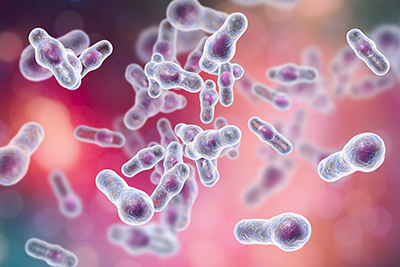By Sara Eaton

Gastrointestinal infections often cause damage to the stem cells in the colon’s epithelium, a thin layer of tissue that covers the outside of the organ, preventing the colon from working properly. Previous research has shown that intestinal stem cells are crucial for the colon to repair itself after damage, but it was not clear how exactly the infections cause damage to stem cells. Researchers in the lab of Borden Lacy, professor of pathology, microbiology & immunology, recently published work showing that the bacterium Clostridioides difficile targets and damages stem cells by secreting an exotoxin, preventing the intestines from fighting off infection and leading to symptoms such as rapid weight loss and severe diarrhea.
In one of three recent PNAS articles from the Lacy lab, researchers investigated the damage to colonic stem cells resulting from C. diff infection and observed how the infection impacted the intestine’s ability to repair itself afterward. The study used C. diff to demonstrate that, in mice, infections with strains that generate more exotoxins cause worse damage deep within the epithelium than strains that produce fewer exotoxins. Exotoxins are proteins released by bacteria to damage specific cells.
In particular, one C. diff strain produces an exotoxin called TcdB. The Lacy lab research revealed that TcdB damages epithelial cells faster than they can be replenished through normal cellular turnover. Using TcdB, C. diff can access the base of a region called the crypt, which is where the colon’s stem cells reside. Damaged crypt bases cannot create new stem cells for the epithelium, so the colon cannot repair damage caused by the CDI and may be more prone to disease recurrence. When TcdB is not produced, CDI damages the epithelium but tends to leave the crypt unharmed, meaning that the colon is able to produce new stem cells to help restore damage. In Lacy’s recent study, mice whose infections damaged crypt bases could not survive longer than 48 hours, while mice that only suffered damage to the epithelium had a 100% survival rate.
This insight into how C. diff strains with TcdB harm stem cells is crucial to discovering how to mitigate CDI effects in patient care settings, especially considering that infections with TcdB-producing strains have worse clinical outcomes. CDIs currently constitute over half of all gastrointestinal infections in hospitals and cause over 90% of deaths from gastrointestinal tract infections. Delays in C. diff recovery due to stem cell damage can be life threatening, so understanding how the damage occurs in the first place can help save patient lives.